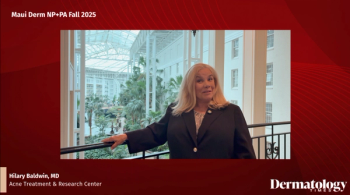
- Dermatology Times, January 2020 (Vol. 41, No. 1)
- Volume 41
- Issue 1
Rosacea classification system can improve
There is still room for improvement to the National Rosacea Society Expert Committee's updated classi fication schema for rosacea, according to William James, M.D.
There is still room for improvement to the
The new guidelines, published in 2018, have abandoned the four main subtypes (erythematolelangiectatic [ETR], papulopustular, phymatous and ocular), replacing them with a phenotype system based upon mostly observable findings.
“Shifting from a subtype focus to individual clinical findings or a phenotype classification allows both for better selection of treatment modalities and improved ability to conduct research,” says Dr. James, co-author of
“By subtyping, there was unnecessary division of interrelated disease into individual disorders; an individual’s clinical presentation might fall along a spectrum rather than within a discrete box,” the authors write.
“Each manifestation is now approached individually, which allows for more exibility and better care,” Dr. James tells Dermatology Times. However, he believes refinements should be made in some of the definitions of the clinical characteristics of rosacea, “not only specifying more precisely the features which comprise the diagnostic findings, but also expanding the list of diseases that need to be excluded when making the diagnosis of rosacea. For instance, providing timelines to fixed erythema and ushing, including periocular sparing in the list of characteristic features, and aiding in assessing how chronic solar damage may be differentiated would be helpful.”
The list of exclusions to the diagnosis has been altered in the new NRS classification system. It lists lupus erythematosus and steroid- and drug-induced rosacea; however, listing seborrheic eczema is confusing, he says.
Dr. James believes the intent is to exclude seborrheic dermatitis, but not atopic or other forms of
“The potential for error, due to a lack of specific detail in defining the individual manifestations and inclusion of non-rosacea disease, still persists,” he says.
Dr. James believes the new phenotype classification system fails to improve on the separation of the polar ends of the rosacea spectrum. More emphasis about the characteristics of those patients at the phymatous pole needs to be emphasized, he says. Recognizing these differences in the basic skin types will allow for better patient education about their prognosis.
“For example, I believe a smooth-skinned, bright red-faced woman will not eventuate into a patient with a large phymatous nose and large pustules and nodules,” he says. “I have not seen evidence that the inflammatory cascades now being recognized as abnormal in such a patient, referred to in the NRS paper as subclinical neuroin ammation, leads to phymatous change. Because most patients with this manifestation are men, I wonder if it is not more in uenced by androgens than in ammation.”
Despite Dr. James’ reservations about the NRS Expert Committee’s update, “there are some excellent changes,” he says. “I applaud that the committee has worked to improve the prior classification system, which I also criticized. While I still would like to see more specificity, the old system was much too general.”
Dr. James believes most dermatologists will embrace the update. “An update was long overdue. I am hopeful that with the pace of progress of new knowledge and new therapeutics that the updates will be more frequent.”
Disclosures:
Dr. James reports no relevant fi nancial disclosures
References:
1. Wang YA, James WD. “Update on rosacea classification and its controversies,” Cutis. 2019 Jul;104(1):70-73.
Articles in this issue
almost 6 years ago
Moisturizers offer easy, low-cost option for kids with atopic dermatitisalmost 6 years ago
Ultrasound technology may be useful treatment for rosaceaalmost 6 years ago
DTC compounded medications: A treatment option for a system in need?almost 6 years ago
Spotlight on Dermira and the QBREXZA storyalmost 6 years ago
Leg psoriasis improves with topical lotionalmost 6 years ago
Are CBD skincare products effective?almost 6 years ago
Nonthermal energy shows promise for back acnealmost 6 years ago
No-cost BRAF test aids therapeutic decision makingalmost 6 years ago
Erythema severity mirrors quality-of-life impact in rosaceaalmost 6 years ago
Fat grafting made easierNewsletter
Like what you’re reading? Subscribe to Dermatology Times for weekly updates on therapies, innovations, and real-world practice tips.


















